|
|
|||
THIS WEEK at HILTON POND
15-21 November 2006
Installment #337---Visitor #
(Back to Preceding Week; on to Next Week)
|
WHEN IT'S DREARY AND COLD |
|
HUMMER FOUND FAR FROM "HOME"
Although laypeople and scientists alike have long been fascinated by hummingbirds, not many folks have devoted themselves to studying these tiniest of all birds. Initial work on hummingbird physiology was conducted by Europeans who experimented with captive birds, while various investigators across the Western Hemisphere have contributed observations about hummingbird nesting and foraging behavior. The majority of the world's 338 hummingbird species are non-migratory and spend their entire lives in roughly the same location, but for those that aren't sedentary we know precious little about their migrational behavior--in part because until fairly recently there have been relatively few people authorized to capture and band hummers. When we first started working with Ruby-throated Hummingbirds (RTHU) at Hilton Pond Center back in 1984, The number of hummer banders has increased dramatically over the past two decades, but there still have been few distant encounters of banded hummingbirds. Based on info from the Bird Banding laboratory (BBL), we estimate all banders who have worked during the past century have captured about 200,000 ruby-throats; of those perhaps two dozen or so have been encountered elsewhere--a 0.01% return on our collective efforts. Amazingly, a young male RTHU (above right) banded here at Hilton Pond Center on 26 September 1991 and recaptured and released by Bob Sargent ten days later at Loganville GA (near Atlanta) was the very first RTHU ever encountered more than ten miles way from its banding site. As noted on the map below, four more of our 3,410 banded RTHUs from the Center have been seen elsewhere--Charlotte NC, Robertsdale (Mobile) AL, and Cameron LA (plus one at nearby Clover SC)--so we were understandably ecstatic this week to learn from the federal Bird Banding Laboratory that one more RTHU had been found at a distant locale far from its "home" at Hilton Pond. 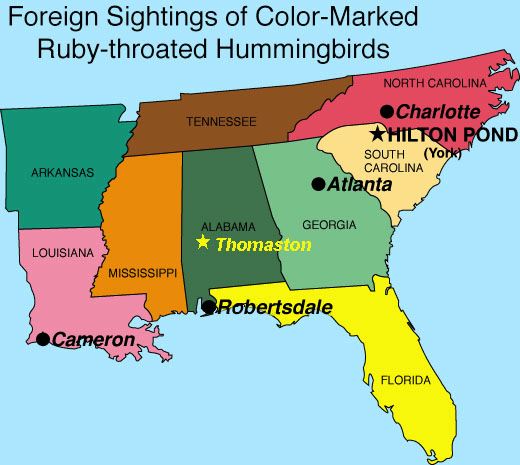
All text & photos © Hilton Pond Center When banders capture a bird, they determine its species and--when possible--its age and sex; we also measure the bird's various parts (e.g., length of bill, tail, and wing chord) and make notes about molt, breeding condition, and other observable characteristics. After we apply a uniquely numbered band of proper size, the bird is released unharmed in the hope it will be encountered elsewhere if it's a migrant. (Non-migrant banded birds also tell us about site fidelity, longevity, and other aspects of avian ecology and behavior.) The success of this whole system depends on willingness of finders to report banded birds, so we're grateful for the initiative of Parrish Pugh of Thomaston, Alabama. According to the printout we received this week from the BBL, Mr. Pugh contacted a local conservation officer who, in turn, reported via the BBL Web site that a hummingbird carrying band number Y16012 had been found dead near a feeder by Mr. Pugh on 1 October 2006. After we submitted our banding data for the just-finished hummingbird research season, the BBL was able to do a computer lookup to determine the bird in question was a hatch-year male Ruby-throated Hummingbird banded at Hilton Pond Center on 17 September 2006--two weeks earlier and 413 straight-line air miles to the northeast of Thomaston AL.
Thanks to Mr. Pugh, his Thomaston bird is the fourth ruby-throated banded at Hilton Pond and later encountered in fall migration SOUTHWEST of the banding site (see satellite map above). These four encounters might not seem all that significant, until we consider that many folks believe all East Coast hummingbirds fly to south Florida in autumn before migrating across the Gulf of Mexico to the Yucatan Peninsula. Florida is due south of Hilton Pond Center, so knowing that at least four of our banded RTHUs were far to the southwest is pretty strong evidence at least some hummers are NOT staging out of Florida for a 500-mile trans-Gulf flight. Instead, it's probable the majority of Ruby-throated Hummingbirds cross the Gulf from a different direction. Some may fly across from extreme southern Louisiana or other coastal points, but we personally have witnessed large numbers of RTHUs taking of from the Gulf Coast of Texas at Rockport and Corpus Christi in a southeasterly direction--undoubtedly heading toward the Yucatan. It is suspected at least some U.S. and Canadian RTHUs take an overland route into their wintering grounds that extend from Central Mexico to northern Panama; Thanks to the cooperation of Parrish Pugh and others who have reported encounters with hummingbirds banded at Hilton Pond Center and elsewhere, we're just beginning to understand fall migrational paths of Ruby-throated Hummingbirds, but there is much more to learn. There obviously needs to be a great deal of work done in Mexico and Central America where "our" RTHUs overwinter after breeding in the U.S. or Canada. We need to educate people who live in these tropical countries to report any banded birds they find, and we need to deploy a bigger network of banders who can observe and capture RTHUs south of the border. That's precisely why we lead an expedition of volunteer citizen scientists to Costa Rica each winter. Now that we've found a dependable concentration of Ruby-throated Hummingbirds near Liberia in Guanacaste Province, we're hopeful hummers we band there will be encountered during northerly migration and/or we'll recapture a RTHU banded by us or a colleague on its breeding grounds. There are still a few spaces available for our February 2007 excursion, for which any interested adult can register as outlined at Hummingbird Expedition to Costa Rica. February isn't that far away, and we can hardly wait to get back to the Aloe Vera fields of Guanacaste (above left) to see what we can learn about hummingbird winter behavior. In the meantime, we'll continue to be very excited about our migratory Hilton Pond hummer, found far from "home" in Thomaston, Alabama and reported by Parrish Pugh. That special bird will never make it to the tropics, but many of its conspecifics will--and we look forward to involving YOU in studying these amazing Ruby-throated Hummingbirds on their Costa Rican wintering grounds in just a couple of months.
All text & photos © Hilton Pond Center
Comments or questions about this week's installment?
Thanks to the following fine folks for recent gifts in support of Hilton Pond Center for Piedmont Natural History and/or Operation RubyThroat: The Hummingbird Project. Your contributions allow us to continue writing, photographing, and sharing "This Week at Hilton Pond." (See Support if you'd like to make a gift of your own.)
"This Week at Hilton Pond" is written & photographed You may wish to consult our Index of all nature topics covered since February 2000. You can also use our on-line Hilton Pond Search Engine at the bottom of this page. For a free, non-fattening, on-line subscription to |

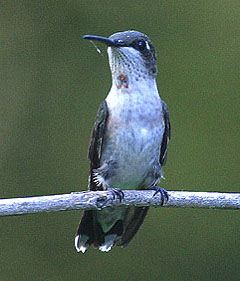 less than 50 hummer banders were active in the U.S. and Canada--many concentrating just on western species--so the chances of someone recapturing or finding a banded RTHU were slim to none.
less than 50 hummer banders were active in the U.S. and Canada--many concentrating just on western species--so the chances of someone recapturing or finding a banded RTHU were slim to none. The bander sends all data--including date and specific location of capture for each bird--to the Bird Banding Lab in Pautuxent MD (left), where the info is logged into a massive centralized electronic database. When someone finds a banded bird and reports its number to the BBL via the toll-free phone line (800-327-BAND) or new on-line
The bander sends all data--including date and specific location of capture for each bird--to the Bird Banding Lab in Pautuxent MD (left), where the info is logged into a massive centralized electronic database. When someone finds a banded bird and reports its number to the BBL via the toll-free phone line (800-327-BAND) or new on-line 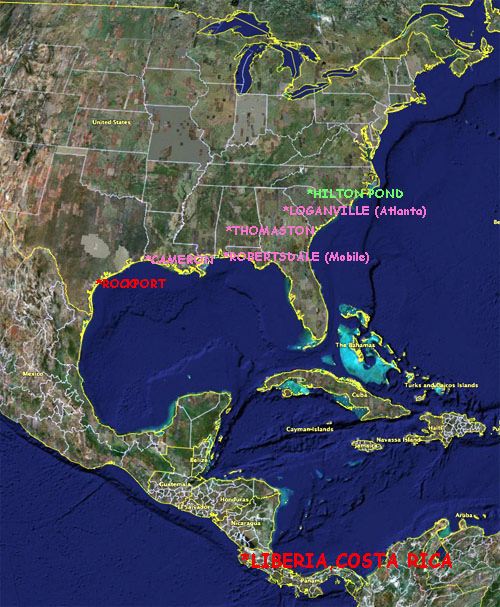
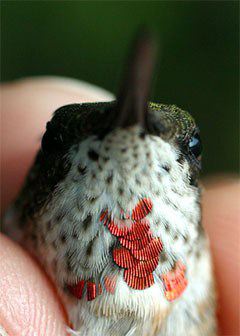 however, no one knows for sure about this because a banded Ruby-throated Hummingbird has never been encountered in Mexico or ANYWHERE south of the Rio Grande River. Thus, not only do we not have solid evidence for an overland migrational path for RTHUS, we don't even understand precisely where they go in winter. Granted, they are observable in Mexico and Central America from September through May, but nobody knows whether all Ruby-throated Hummingbirds from Virginia go to Nicaragua while those from South Carolina go to Honduras . . . or vice versa . . . or neither.
however, no one knows for sure about this because a banded Ruby-throated Hummingbird has never been encountered in Mexico or ANYWHERE south of the Rio Grande River. Thus, not only do we not have solid evidence for an overland migrational path for RTHUS, we don't even understand precisely where they go in winter. Granted, they are observable in Mexico and Central America from September through May, but nobody knows whether all Ruby-throated Hummingbirds from Virginia go to Nicaragua while those from South Carolina go to Honduras . . . or vice versa . . . or neither.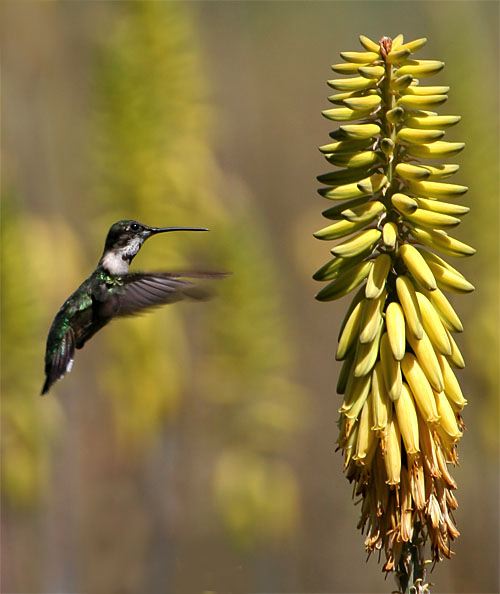 It would be tremendously exciting if either of these scenarios should occur because it would give us a key to begin unlocking some secrets of RTHU migration.
It would be tremendously exciting if either of these scenarios should occur because it would give us a key to begin unlocking some secrets of RTHU migration.

 Oct 15 to Mar 15
Oct 15 to Mar 15
